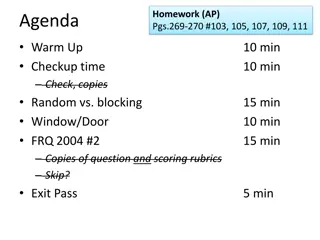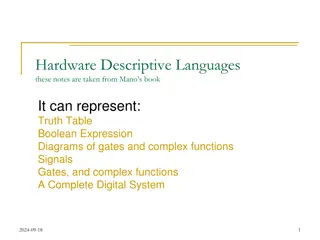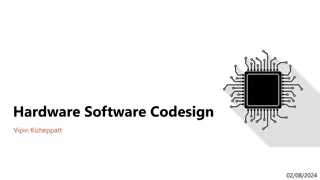Understanding Blocking and Non-blocking Assignments in Verilog
Explore the intricacies of segregating blocking and non-blocking assignments to separate always blocks in Verilog. Learn about the differences between blocking and non-blocking assignments, their implications on sequential execution, and how to use them effectively in hardware description language programming.
- Verilog
- Hardware Description Language
- Blocking Assignments
- Non-blocking Assignments
- Sequential Execution
Download Presentation

Please find below an Image/Link to download the presentation.
The content on the website is provided AS IS for your information and personal use only. It may not be sold, licensed, or shared on other websites without obtaining consent from the author. Download presentation by click this link. If you encounter any issues during the download, it is possible that the publisher has removed the file from their server.
E N D
Presentation Transcript
Why segregate blocking and non-blocking assignments to separate always blocks? always blocks start when triggered and scan their statements sequentially Blocking assignment: = (completes assignment before next statement executes) Non-blocking: <= (all such statements complete at once at end of the always block)
A mixed always block for a funny shifter module funnyshifter (input data, clk, output reg [3:0] yout); reg [3:0] asig; initial asig = 4'b0000; always @ (posedge clk) begin asig[1] = asig[0]; asig[2] = asig[1]; asig[3] = asig[2]; asig[0] = data; yout[3:1] <= asig[3:1]; yout[0] <= data; end // Value of asig(0) on entry written to asig(1) at // end of loop - D-ff // Value of asig(1) as step written is already // updated so asig(2) = asig(0) at end of loop // Value of asig(2) as step written is already // updated so asig(3) = asig(0) at end of loop // asig(0) = data at end of loop - D-ff // non-blocking unambiguous D-ff's endmodule
Simulation results for different order of statements Result with first statement order: asig[3:1] are redundant Swap first and third lines and there is a double shift register
Same mixed always block but different statement order - designer s probable intention module funnyshifter (input data, clk, output reg [3:0] yout); reg [3:0] asig; initial asig = 4'b0000; always @ (posedge clk) begin asig[3] = asig[2]; asig[2] = asig[1]; asig[1] = asig[0]; asig[0] = data; yout[3:1] <= asig[3:1]; // non-blocking unambiguous D-ff's yout[0] <= data; end // Value of asig(2) on entry written to asig(3) at // end of loop - D-ff // Value of asig(1) on entry written to asig(2) at // end of loop - D-ff // Value of asig(0) on entry written to asig(1) at // end of loop - D-ff // asig(0) = data at end of loop - D-ff endmodule
The right way to do it: module funnyshifter (input data, clk, output reg [3:0] yout); reg [3:0] asig; initial asig = 4'b0000; // and has no effect on hardware. I needed it to generate the // simulator output by starting in a known state. always @ (posedge clk) begin asig <= {asig[2:0], data}; // non-blocking unambiguous D-ff's yout[3:1] <= asig[3:1]; yout[0] <= data; end endmodule // Note: this line initializes only the simulator
Suggested Rules and Styles Avoid writing modules that mix the creation of state in an always @ posedge block with the definition of the next-state function. .. (This) sidesteps a tremendous amount of confusion and frustration that result from incorrect use of blocking = versus non-blocking <= assignment. Dally and Harting, Digital Design a Systems Approach, pp. 593-594 Two rules are so important this is the only place that you ll find bold font in this book. Always use blocking assignments (=) in always blocks intended to create combinational logic. Always use non-blocking assignments (<=) in always blocks intended to create registers. Do not mix blocking and non-blocking logic in the same alwaysblock. John F. Wakerly, Digital Design Principles and Practices, pg. 316.
A Strong Style Preference: Rule: in any always block, you must not leave ambiguity all possible input conditions should have fully specified output conditions Common logic expression formats include: always @ (*) begin if (adv = 1 b1) next = 0; // will get latch or permanent 0; end always @ (*) begin // PREFERRED STYLE case() // USE case() for multiple choices 1 b1: next = 0; 1 b0: next = 1; // Preferable to include all cases default: next = 1; // ALWAYS supply a default. endcase assign next = adv ? 0 : 1; // Satisfactory for single bit usage inside or outside always block























